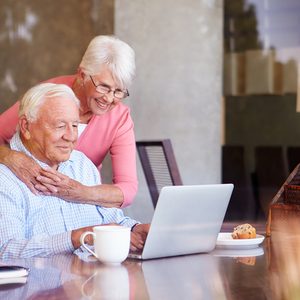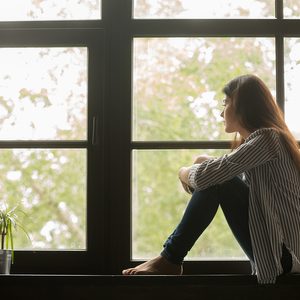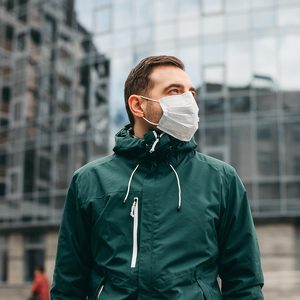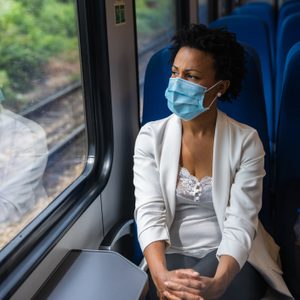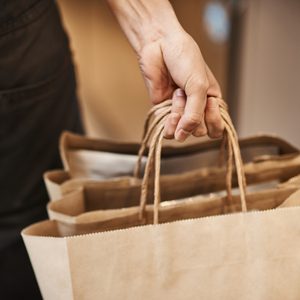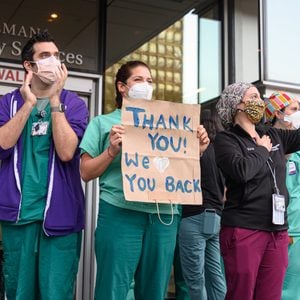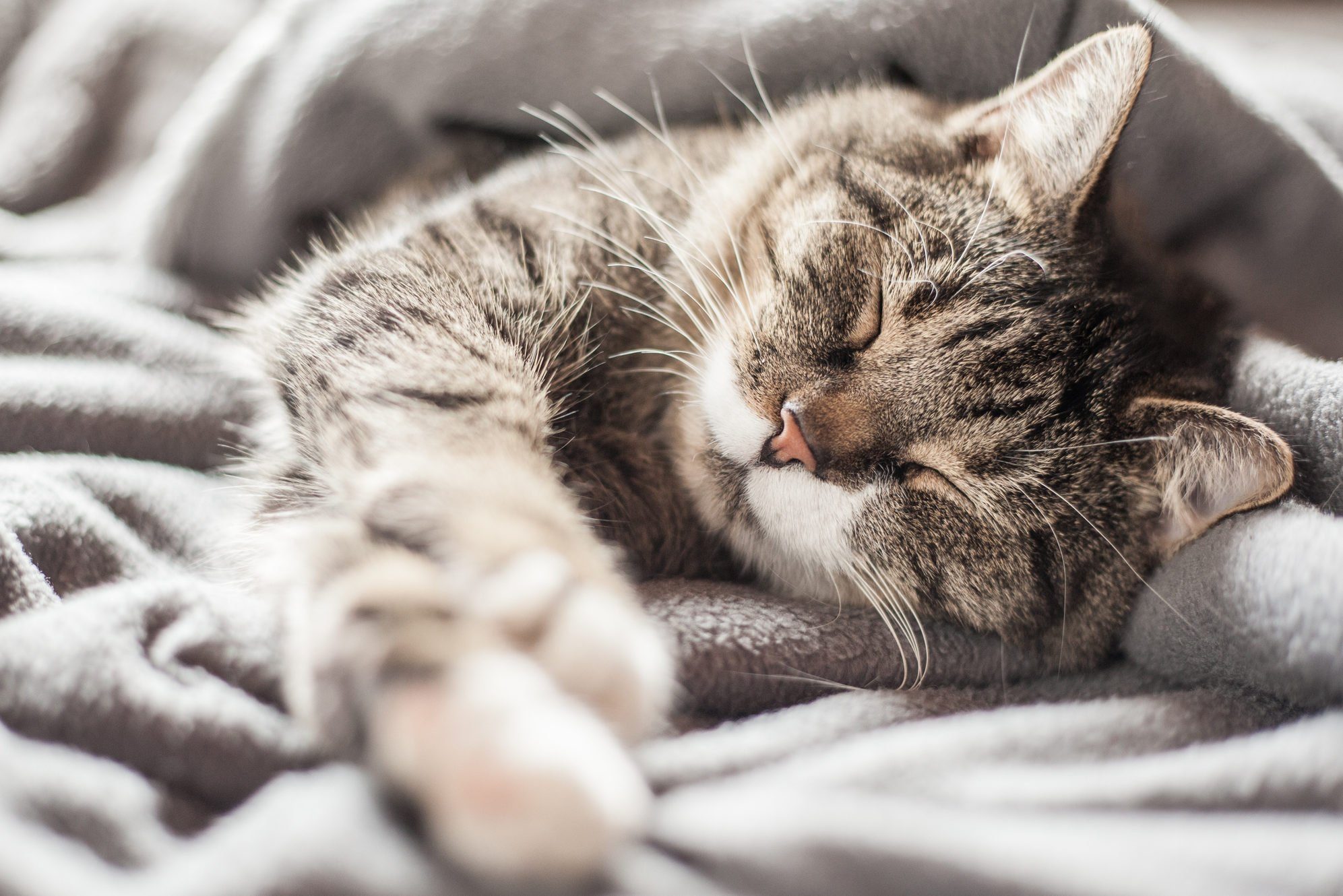
Taking a cat nap
You’ve probably seen your cat curled up taking a nap in patches of sunlight at all hours of the day. Cats spend a lot of their time sleeping—on average 12 to 15 hours—and it’s not because they’re lazy. We know that dogs dream, but do cats dream, too? And what kinds of things would cats dream about, anyway?
Do cats dream?
“Research has shown that all mammals dream. During sleep, the mammalian brain needs to organize and arrange images from the day,” Dr. Katy Nelson, senior veterinarian at Chewy, tells Reader’s Digest. “Scientists have concluded through studying rats’ brains that the level of brain activity while doing puzzles or navigating mazes is similar to the activity level measured during REM (rapid eye movement) sleep–the deepest level of sleep–proving that they do dream.” (How many of these cat myths did you believe were true?)
Why do animals sleep?
After staying up late and having to wake up early the next morning, you learn pretty quickly how important sleep is for your health and well-being. Sleep, of course, is important for animals, too. “Understanding the process of sleep helps to explain dreaming. Sleep is a state of reduced consciousness characterized by reduced sensory and voluntary muscular activity,” says Dr. Nelson. “Sleep aids growth and the repair of body systems. During sleep, the brain seems to process information learned during the day, as well.”
Do cats dream similar to humans?
You’ve probably woken up on numerous occasions remembering your dream and wondering what it meant. Does that mean cats have similar experiences? “During non-REM sleep, the brain takes images seen throughout the day and rearranges them in dreams to better process and understand what was seen. A similar scenario is how film editors take different video clips and arrange them to create a storyline,” Dr. Nelson explains. “When humans and pets actually ‘watch’ the edited footage is during REM sleep when the body’s serotonin system slows down. Serotonin’s primary job is to control large muscle groups, which is why we ‘go limp’ during REM sleep but can still have eyelids fluttering, feet moving, facial twitching, etc., because those are considered fine motor movements.” (Here’s why vets and cat experts say cats like boxes.)
REM sleep versus non-REM sleep: What’s the difference?
“As discussed above, there are two types of sleep: REM and non-REM,” says Dr. Nelson. “During REM, the sleeper’s eyes move rapidly and the brain’s activity is similar to an awake state. This is when dreaming occurs. Young animals spend more time in REM than older animals possibly due to the large amount of new information that they encounter each day and the need to process it all.”
What do cats dream about?
People dream about their lives and cats seem to dream about their lives, too. “Well, since we’re unable to ask them what they dream about, we have to deduce that, similar to us, they dream about their day,” says Dr. Nelson. “If they went outside and saw a bird and another kitty friend, those images are likely what is playing through their mind during sleep. Perhaps they’re even dreaming about you, their delicious dinner, and the pens and chapstick that they pushed off of your table just so they could watch them fall!”
Are cats dreaming when they move or make noise in their sleep?
“Scientists believe that they are dreaming during these times,” says Dr. Nelson. “These fine motor muscles are reacting to the images being replayed in their minds.”
Do cats have nightmares?
Have you ever been startled awake from a nightmare that seems just a bit too real? Cats probably have the same experience. “Just like us, animals’ dreams may not always be happy or based on their reality. Nightmares are suspected to be the way that our minds determine the best course of action in case that dream experience occurs during waking hours,” says Dr. Nelson. “Our cats aren’t likely to dream of monsters or missing a final exam like we do, but who knows… maybe they dream of oversized mice or seeing the bottom of their food bowl!”
Next, check out the cat breeds that get along with dogs!
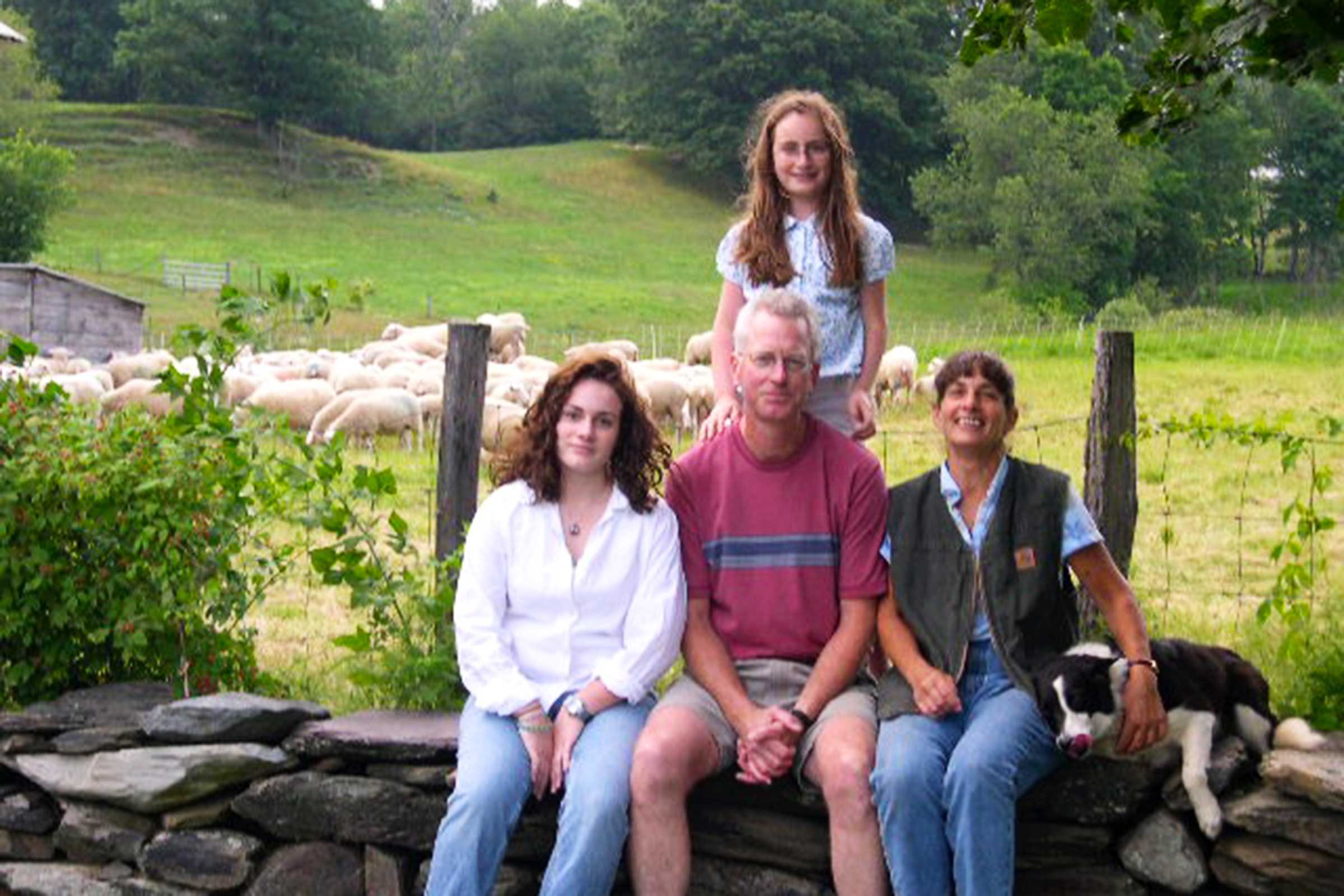
For Emily Borghard, 28 (pictured left), life growing up on a farm in upstate New York was filled with carefree activities in her close-knit community. Volunteer work with local soccer programs took up much of her time, and when her first seizure hit, she was a senior in high school applying for college admission miles away from home. Epilepsy causes seizures as a result of unusual electrical activity in the brain, usually due to brain injury—though often it has no identifiable cause.
“My first seizure occurred during a car accident. I was going home after a sleepover with my friends and I drove right off the road into a creek. I live in such a small town that the closest hospital is an hour away,” she explains. “I was lucky that someone saw it happen because, if not, they might not have known I was in the creek. They had to fly me to the hospital and the whole town knew what had happened by the time they contacted my parents because they had to clear the football game to land the helicopter.”
Borghard’s memory of the event is blank, but she gathered details from local media reports. She says, “I really have no memory of it, but I can talk about it because I have seen the police reports, news, and what my parents have told me. EMS witnessed seizures on the scene but it took a long time for the puzzle pieces to come together and for us to finally know that a seizure, in fact, caused the accident.” (Here’s what an epileptic seizure really looks like.)
Convincing the doctors
Although emergency responders witnessed Borghard’s seizures, physicians were hesitant to believe that she had epilepsy, says Borghard. “I became very frustrated because, for months after the car accident, I knew something was wrong, but neurologists were telling me I was fine. I was having blackout spells, and episodes of falling to the ground, yet I was being told that I was faking the seizures because they saw nothing on the EEG reports.”
The doctors’ disbelief made Borghard begin to doubt herself. She explains, “Being told I was faking the seizures was terrifying and frustrating. I began to doubt that there was something wrong, and I actually began to believe that maybe I was just nuts, and making this all up.”
As her epileptic symptoms began to increase at a feverish pace, doctors finally began to take notice. She recalls, “I was having hundreds of episodes or “spikes” a day. I was not functioning. I could not recall day-to-day events and every time I had an episode it was like getting hit in the head with a baseball bat—my memory of it was gone. Once the neurologists were finally willing to entertain the idea that I had epilepsy, they tried out some medications, but none of them worked to stop or reduce my seizures.”
A failure to respond
Doctors can treat 70 to 80 per cent of epilepsy patients with medications or surgical techniques that target affected portions of the brain. Unfortunately for Borghard, she fell into the group who didn’t respond to traditional methods. Even though epilepsy affects one in 26 people, the lack of successful treatment fed into her doctors’ suspicions that she was faking her symptoms. “They thought this proved their point that I was pretending to have the seizures. I knew I wasn’t, I just didn’t know what to do,” she explains. “I was trying to live life normally as a college student, and instead, my roommates were calling my parents and saying, ‘Emily is on the floor again,’ or ‘We had to call the campus EMS.'”
The impact of her undiagnosed epilepsy began to take a toll on her life, to the point that her dream of graduating from college looked as though it might not become a reality. “I really had no idea if I could make it through college,” she remembers. “Going away to college is scary enough, and I was trying to do this with undiagnosed and uncontrolled epilepsy that I was told was nonexistent. I was trying to get through classes, but the information I was studying was being deleted every night as I slept, and my brain was having seizures. I often compared my life to the movie 50 First Dates.”
Not only are seizures emotionally draining, but they take a toll on the body as well. “Physically, seizures are tiring,” says Borghard. “Even the little ones that last seconds are like running a mini race. Afterward, I can tell I had one because I’m tired. My friends and family sometimes recognize that I’ve had a seizure and I don’t (because they are so fast), because I’ll repeat myself and forget things.”
Finally, hope
Thanks to a friend, Borghard found her way to Lawrence Hirsch, MD, professor of Neurology at Yale University. After meeting with Dr. Hirsch, Borghard says she finally knew she would receive the help she had been looking for. “As soon as my parents and I met him, we had a good feeling. He did not doubt the seizures were real and he felt they needed to be looked at very closely—and that there was a cause. It was clear that he was going to help me.”
Help for Borghard came in the form of an implantable neuro-stimulating device that is placed within the brain at the most active seizure locations; it was designed to treat medication-resistant epilepsy. Similar to a pacemaker, the device monitors and reacts to brain activity. Desperate, Borghard signed up for the treatment, and she hasn’t looked back: “If you had asked anyone who knew me after I began having seizures if they thought I would be where I am today, they would have laughed. I was barely functional. Since the surgery, I spent three years in France teaching English at inner-city schools. I returned to America and graduated from Fordham University with my master’s in clinical social work.”
Today, Borghard is living the independent life she always expected to have before the car accident that changed everything. She explains, “I’m living on my own and I know that I can do that without any fear. I am practically seizure-free. There are some seizures here and there, but they last seconds. My neurologists were able to program the device to make my right eye twitch when my brain activity reaches a certain level, meaning there is a cluster of activity, and then I know I have to take extra medication.”
Borghard feels that her experience taught her the persistence it requires to find a solution to epilepsy: “It is not a sprint to the finish, it is a slow marathon. It takes patience to figure out the right combination of drugs, and to program the device specifically to meet individual needs,” she says. “This diagnosis does not define me—I do, and I go out and live my life.”
Next, read about the strange symptoms that can signal a serious disease.
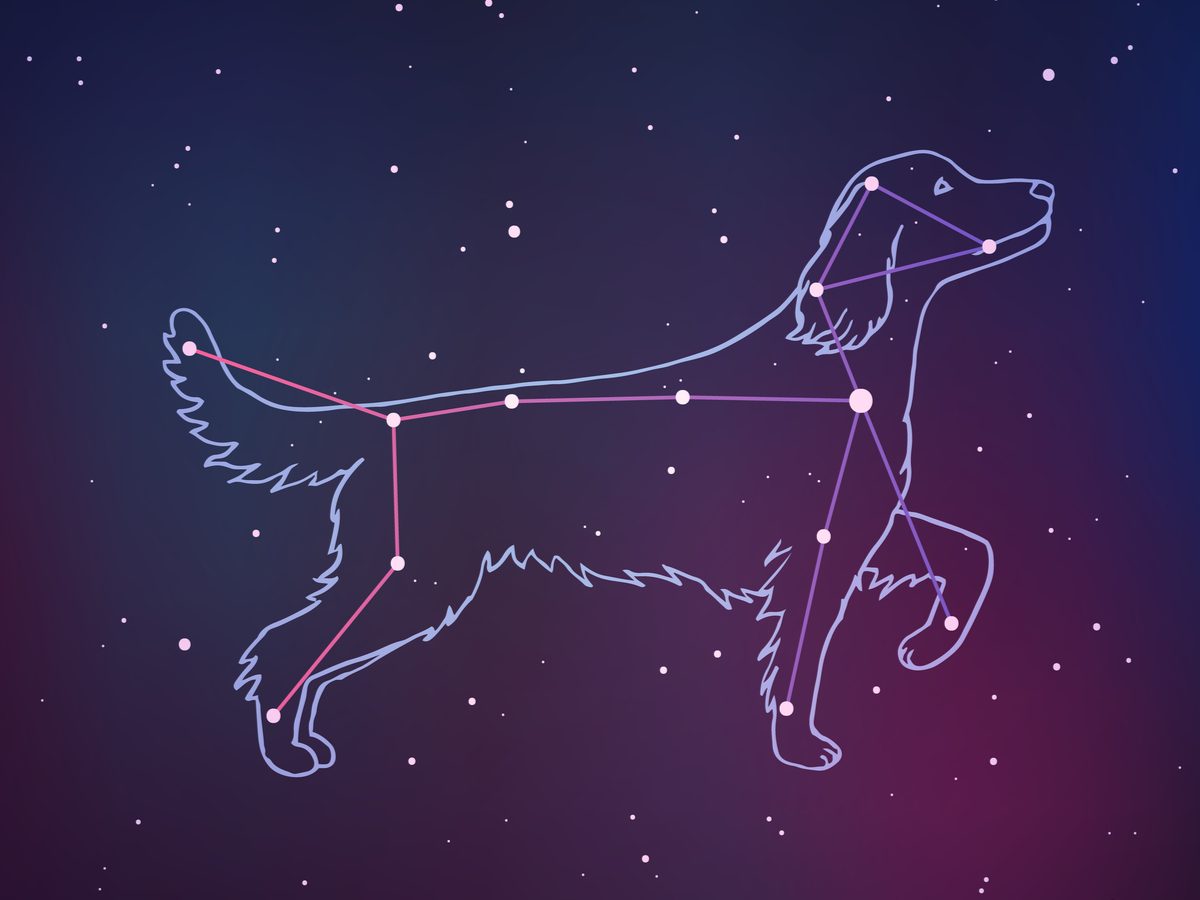
This year, while your summer plans may change due to COVID-19, the weather will still be hot. But what are the dog days of summer, and what do those days have to do with dogs?
“Sirius”-ly surprising origins
The phrase “dog days of summer” actually has nothing to do with man’s best friend. It turns out that the ancient Greeks and Romans weren’t referring to real dogs, but to the great astronomical one, Sirius. The “Dog Star” is located in the constellation Canis Major, known as the Greater Dog, and is the brightest star that shines at night.
Sirius is also known as “Nile Star” or “Star of Isis” because ancient Egyptians noticed 4,000 years ago that around the summer solstice, Sirius would appear to rise before dawn, which would be around the time when the Nile River would flood. Since ancient Egyptian life depended on agriculture, the flowing river would either bring great prosperity or great destruction. (Check out these fascinating facts about the summer solstice.)
Why “dog days of summer”?
What does the star Sirius have to do with the “dog days of summer”? According to the Farmer’s Alamanac, during summer months and specifically on July 23rd, Sirius is extraordinarily bright and, in certain parts of the world, rises and sets with the sun at that time. Ancient Romans believed this shining star contributed to the sun’s heat, thus referring to this extremely hot period as diēs caniculārēs, or “dog days.” The term evolved to mean the 20 days before and after July 23rd, or July 3 to August 11, to coincide with Sirius aligning with the sun. However, depending on where you are in the world, the astronomical dog days and the rising of Sirius vary.
You could also find references to the “dog days of summer” in ancient texts. “If you go back even as far as Homer, The Iliad, it’s referring to Sirius as Orion’s dog rising, and it describes the star as being associated with war and disaster,” Jay B. Holberg, author of Sirius: Brightest Diamond in the Night Sky and senior research scientist at the University of Arizona Lunar & Planetary Laboratory tells National Geographic. “All throughout Greek and Roman literature, you found these things.” The phrase “dog days” has since taken on various meanings after its translation from Latin to English. (These are the Latin words you use every day without knowing it!)
What does science have to do with it?
Even though Sirius is extremely bright, the extra heat is not because of any additional radiation from this star. The earth rotates around the sun and the Earth’s tilted axis is why we experience seasons. The sun is hotter in certain hemispheres because the sun’s rays hit the Earth in a more direct way due to Earth’s tilt. For example, if the North Pole is tilted toward the sun, that translates to hotter days in the Northern Hemisphere. Similarly, if the South Pole is tilted toward the sun, that means it’s winter in the Northern Hemisphere. However, stars shift, the earth wobbles, and the “dog days” of ancient Greece aren’t the same “dog days” of now, and the “dog days” of now won’t be the same as thousands of years from now.
How do you see Sirius?
To find Sirius in the night sky on winter evenings, locate the Orion constellation and then find Orion’s belt. Once you’ve located the three stars that make up Orion’s belt, move in a line down to the left until you find Sirius.
Here are the world’s most contagious myths and misconceptions—debunked.
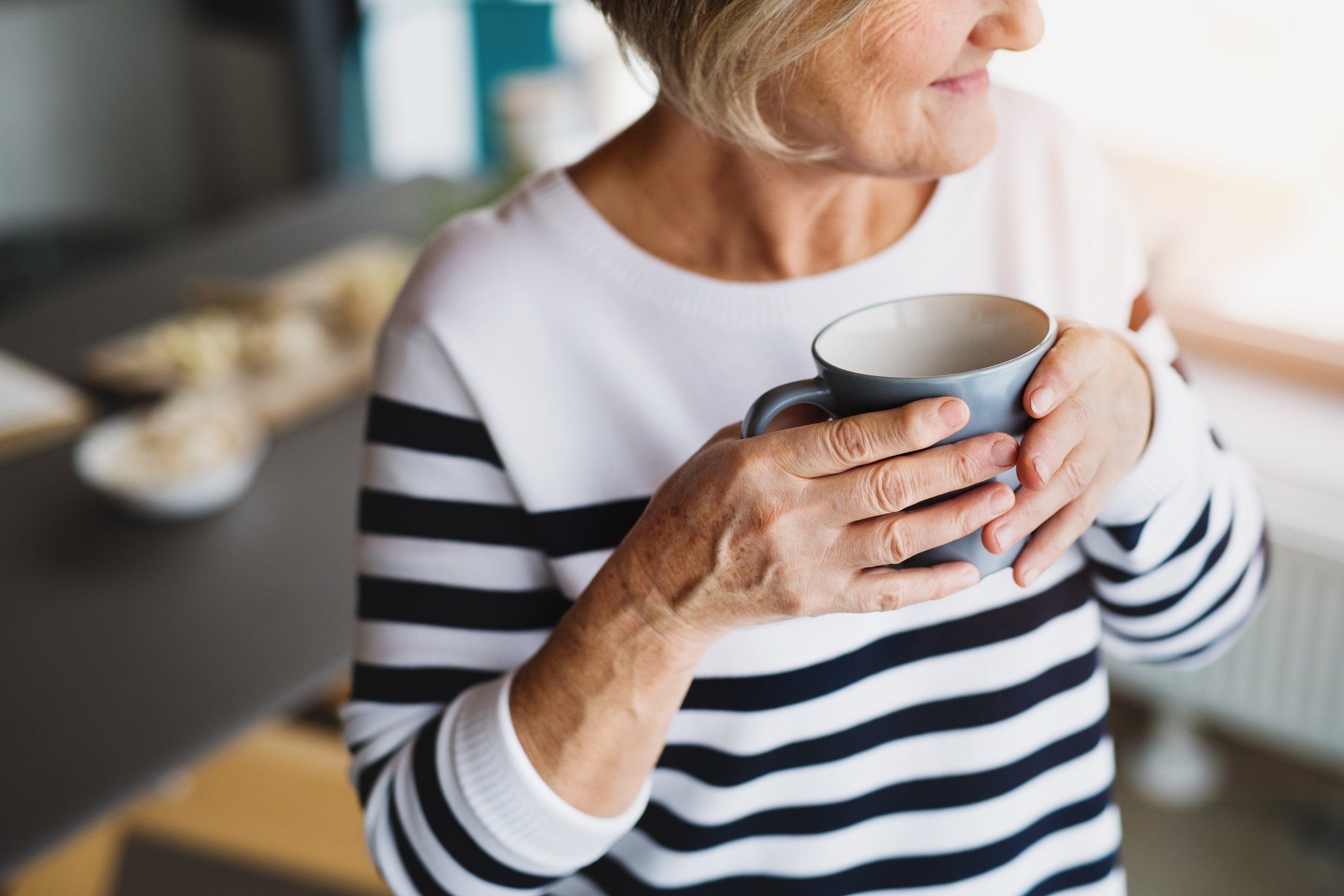
Here’s good news for coffee drinkers everywhere: Having a daily coffee habit may actually be a good thing.
Yes, coffee once had a reputation for being bad for you, and it was even classified as a possible carcinogen by the International Agency for Research on Cancer in the early ’90s. “However, the past 25 years have yielded better-quality data and expanded our understanding of coffee’s impact on health,” says Shahzadi Devje, RD, a certified diabetes educator in Toronto. “And the case for coffee is stronger than ever.”
One thing to keep in mind, though, is we’re purely talking about coffee itself. “The benefits studied are generally from the coffee,” says Ginger Hultin, RD, a Seattle-based spokesperson for the Academy of Nutrition and Dietetics. “So if you drink coffee with added sugar or high-fat cream products, those additions may negate the health benefits.”
Of course, dietary habits are all about balance and moderation. So if you’re adding just a sprinkle of sugar and that’s your only source of added sugar for the day, you may be OK. But you might also find that a dash of cinnamon in your java is all the sweetness you need.
Now, let’s get into those health benefits.
Regular and decaf coffee contains antioxidants
“Coffee is one of the most plentiful and consistent sources of cell-protecting antioxidants, since many people consume it daily,” says Dana Angelo White, RD, a certified athletic trainer in Fairfield, Connecticut. Indeed, coffee is one of the main sources of antioxidants in the Western diet, per a 2014 study in Antioxidants.
What about decaf? When it comes to antioxidants, “both regular and decaf coffee have similar amounts,” explains Melissa Nieves, RD, who is based in San Juan, Puerto Rico. “However, it seems that the caffeine extraction process may somewhat reduce the amounts of phenolic acids and antioxidant capacity in decaf coffee.” In a nutshell: Regular coffee may offer more health benefits than decaf, but you’ll still get health perks from decaf coffee. (Add these antioxidant-rich fruits and vegetables to your grocery list, too!)
Coffee may help reduce inflammation
A major benefit of consuming antioxidants on the daily: Doing so may help reduce inflammation. “Most of the reported health benefits of coffee bank on the premise that coffee may have antioxidant and anti-inflammatory properties that, over time, may reduce inflammation,” says Devje. Wondering what reducing inflammation accomplishes? It may ultimately decrease your risk of chronic disease, per a 2017 review study in Annual Review of Nutrition that found that coffee intake was associated with a lower risk of type 2 diabetes and Parkinson’s disease, among other conditions.
Coffee may help prevent cancer
“Observational studies have linked coffee consumption with a probable decreased risk of breast, colorectal, colon, endometrial, and prostate cancers,” says Devje, referring to the previously mentioned Annual Review of Nutrition study. Drinking four- to five cups of coffee a day was associated with lower risk of developing some cancers, but “keep in mind that the data is observational in nature, and we cannot assume a cause and effect relationship,” Devje cautions.
Coffee is linked to a lower risk of depression
Yup, some research suggests that drinking java is linked to a lower risk of this mood disorder. “A large longitudinal Harvard study with more than 50,000 women found that women drinking moderate amounts [of coffee] had a lowered risk of depression,” notes Jeni Hollifield, RDN at Healthy Grocery Girl in Colorado Springs, Colorado. In the study, published in JAMA Internal Medicine, women who drank two to three cups of coffee a day had a lower risk of depression than women who drank one or fewer cups per week. Drinking decaf coffee wasn’t connected with a lowered risk of depression in the study.
Coffee may aid heart health
Here’s great news to anyone with a family history of heart health problems: Having a coffee habit may lower your risk of heart disease. A review study in Circulation found the biggest benefit to fall at three to five cups of coffee a day. Drinking coffee may help reduce risk of other types of heart problems, too. “The American Heart Association observed that drinking coffee was associated with decreased risk of developing heart failure by seven per cent and stroke by eight per cent with every additional cup of coffee consumed per week, when compared with non-coffee drinkers,” says Nieves.
And finally, sipping java may help reduce the risk of atrial fibrillation, which the American Heart Association notes may lead to stroke. Regularly consuming up to 300 milligrams a day of caffeine may be protective against heart rhythm disorders, according to a 2018 study in the JACC: Clinical Electrophysiology.
Coffee may enhance your focus
“Caffeine improves performance on simple and complex attention tasks, as well as alertness,” says Devje. A small March 2020 study in Consciousness and Cognition found drinking coffee may improve your concentration, but not your creativity. In the study, the researchers gave 200-milligram caffeine pill (one cup of coffee) or a placebo to a small group of 80 people. Upon reviewing caffeine’s effect on problem-solving, idea-generation, working memory, and mood, the researchers found caffeine enhanced their problem-solving abilities. These effects would have to be tested in larger populations.
Coffee may help you be a better athlete
Yes, coffee can help you win the race. “Caffeine has the power to enhance athletic performance and aid in muscle recovery post workout,” says Angelo White. “Coffee is a good vehicle for safe doses of caffeine, as many supplements containing the stimulant aren’t properly regulated and often have inaccurate labeling. Plus, the amount of caffeine found in a typical medium-sized coffee has been found to be effective.”
How much coffee should you drink?
Now that you’re well aware of coffee’s benefits, it would help to know how much should you be drinking a day. The U.S. Food & Drug Administration advises capping intake at 400 milligrams of caffeine per day, which typically equates to three to five cups. “Many studies indicate that this moderate consumption is the limit where they see benefits,” Hultin says. Pregnant women should limit intake to no more than 200 milligrams per day, according to the March of Dimes.
Beware, though, that some restaurant coffees contain more caffeine than the typical cup. Even an eight-ounce tall Starbucks Reserve Roast has 190 milligrams of caffeine, while that amount almost reaches the daily limit if you go for a 16-ounce grande, the Caffeine Informer reports.
Too much caffeine can cause other issues. “More than five cups of coffee a day has been shown to cause problems due to caffeine intake,” says Hollifield. “Consuming too much caffeine can lead to anxiety, rapid heart rate, upset stomach and even high blood pressure. Caffeine affects all people differently depending on your genetic make-up and how your body metabolizes the caffeine.”
Of course, if you’re not already a coffee drinker, you don’t need to start a java habit. “You don’t have to drink coffee to be healthy,” says Hultin. “One of the most interesting benefits is that it has antioxidants. You could get those from tea or from other foods like fruits and vegetables. It’s important in general to eat a diet that contains whole foods due to their vitamins, minerals, and antioxidants. Health comes from the whole, big picture.”
Next, find out the best time of day to have coffee.
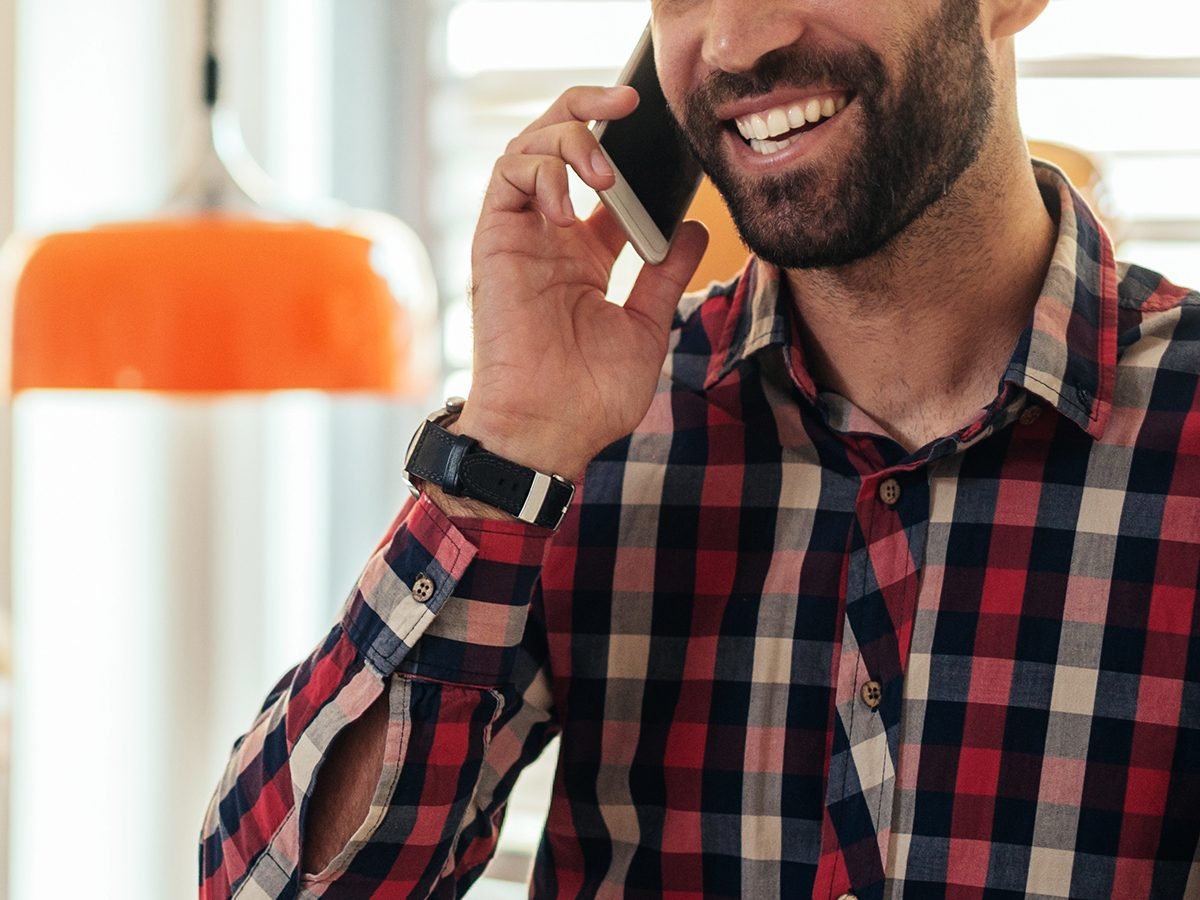
Not long after the COVID-19 pandemic shut down businesses across Canada and threw our daily lives off-kilter, I received an unexpected email. I was delighted—not to mention surprised—to find it was from an Italian friend I had met more than 30 years ago, when I was a student backpacking around Europe. Knowing that Italy was in a similar state of lockdown at the time, it was comforting to hear from him. Stuck at home in such a stressful situation, his message—essentially a simple “hello”—made my day, and made me feel connected; part of a bigger global community.
It shouldn’t take a crisis for us to reach out to people we don’t see enough. But maybe that very crisis was the perfect opportunity to spread some kindness around. Since the lockdown had knocked me out of my routines and handed me—and everyone else who isn’t a frontline worker—a lot of free time, I figured I’d follow my Italian buddy’s example and turn the pandemic into an opportunity to be a better friend. I’d reach out to whoever came to mind, no matter how long it had been since we’d last spoken. I didn’t have any particular goal except to pleasantly surprise the people I care about during a time when every day felt like a dreary repeat of the day before.
The pandemic seems to have made everyone an expert on videoconferencing apps like Zoom. But I often feel frustrated by the lack of direct eye contact, the low resolution and the frequent technical glitches. So instead, I found myself using the telephone—a technology I had mostly abandoned over the last decade. I rediscovered how the phone can be a hassle-free way to reach out, putting the focus on voice and words, not overgrown hair or the distracting mess in the background. The lockdown also eliminated the nuisance of playing telephone tag—almost all the people I called were home and answered. If not, I left a short and friendly message, and people usually called back.
Hearing from a long-lost friend during the pandemic might be unexpected, but it doesn’t have to be awkward. “It’s a matter of being honest and coming from a place of love, just saying, ‘I randomly thought about you, how are you doing?’” says Melanie Tsesler, a Toronto-based psychotherapist.
Curiously, I found some “in real life” friendships were harder to convert into socially-distanced ones over the phone. A conversation with a casual friend who I’m always happy to see at parties quickly ran out of steam—it became clear that our interest in each other depended on that lost context. Other relationships were better able to handle a change of channel. I caught up with an old classmate from high school while she and her husband ran errands; she described what they were passing on the rural roads they were driving, while I talked about what I could see out of my window.
Tsesler says it’s important to respect boundaries, giving friends and acquaintances from our past the ability to decide if and how they want to interact with us. It’s about being a good friend with good vibes, not about criticizing or rescuing people. “A lot of times we want to problem-solve for other people; [to] give them advice,” says Tsesler, “but they might not need that.” Often enough, I found the content of my calls mattered less than just giving people my time and attention. A friend who had lost her job in the hotel industry enjoyed talking about our past adventures, like a road trip to a wedding, partly as a distraction from the stress and uncertainty of what she was now facing.
I was able to rekindle several friendships that had fizzled out and, at the very least, remind a few old friends that I still exist. My Italian buddy and I have exchanged more messages in the last few months, and his city is now at the top of my list of places to visit when travel restrictions are lifted.
In a crisis, we obviously need to be there for the people who need us most. But reaching out to people who might need us just a little bit can help take the edge off a difficult time—for both the caller and receiver.
Here’s what travel could look like after the COVID-19 lockdown.
Especially in the summer months, dehydration can be a real danger. “Many people are not drinking enough,” says Amy Goodson, a registered dietitian in the Dallas-Fort Worth area. And that can lead to some really big problems: a parched body is sluggish, and a parched brain can’t think as well, according to the Centers for Disease Control and Prevention (CDC). Not getting enough water can also leave you more prone to constipation, overheating, and kidney stones. (Find out more surprising health benefits of staying hydrated.) The best defense is a good offense, and that means having a hydration plan, says Goodson. To feel your best, here are seven times when you need to drink up more.
You’re at happy hour
“Alcohol is a dehydrator,” says Goodson. A cold beer on a hot summer day might be refreshing, but alcohol acts as a diuretic, which essentially means you’ll pee out excess body fluid. (Dehydration is one reason that too many boozy beverages practically guarantee a hangover.) While it’s recommended that women limit themselves to one alcoholic drink per day and men limit it to two, there may be times when you’re out socially and consume more than that. A good rule to follow, Goodson says, is to drink a glass of water in between every alcoholic drink when you’re out.
You’re hanging out at your kids’ game
You may be focused on your kids drinking enough water, but think about yourself, too. “Some people are really sensitive to heat and humidity, and they can overheat when simply sitting outside in the sun,” says Goodson. Just as you filled up their water bottle—and are after them (with love!) to take a sip, listen to your own advice: BYO bottle and keep it by your side. No one wants to sip warm water on a hot day, so use one that’s insulated with stainless steel (rather than plastic) to keep the contents pleasingly cold and refreshing. (Here are more sneaky ways you’re making yourself dehydrated.)
You’re pregnant
Your body is working overtime to form the placenta and amniotic sac, maintain a higher blood volume, as well as grow and nourish a baby, a physical load that requires a lot more water than the average person, according to the American Pregnancy Association. Dehydration can cause you to overheat faster. The Office on Women’s Health recommends that pregnant women consume 10 cups of fluids per day, which includes water, juice, coffee, tea, and other beverages. Pay attention to your urine (easy to do when you’re peeing a lot anyway): It should look pale yellow or clear.
You have heart disease
While it may be important to eat healthfully by following good-for-your-ticker diets like the Mediterranean, and exercising, it’s also critical for you to drink more water, says the American Heart Association. Dehydration means you’ve lost water throughout your body, and that includes in your blood. “Thicker” blood is tougher for your heart to move around your body. Water—rather than sugary beverages like sports drinks, juice, or sodas—is best, since these options pack a lot of extra sugar, which is not good for heart health. If you need some pizazz, try lemon water, which offers a surprising range of benefits. (Find out exactly how much water you should drink to stay hydrated.)
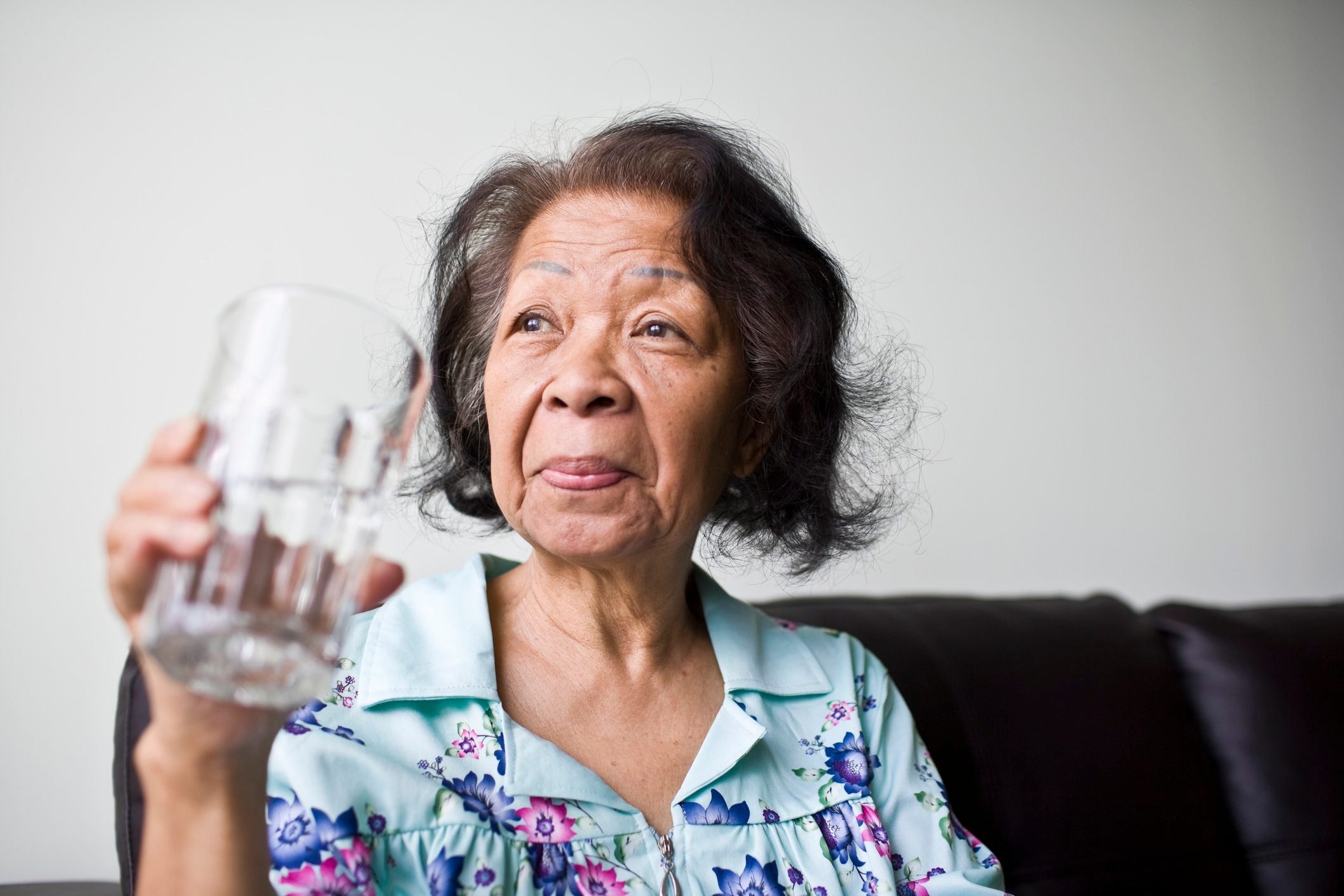
You’re an older adult
“As people age, sweat glands don’t produce as much sweat, which can contribute to a higher body temperature,” explains Goodson. That’s why aging adults are more at risk for dehydration and overheating. Making things worse, she says, elderly people begin to lose sensitivity to thirst so the natural cue to consume H20 isn’t as strong. What’s more, dehydration can cause confusion, seizures, or be fatal, yet most elderly individuals are not aware of these risks, according to a 2017 study in the journal Nutrition and Healthy Aging. For older adults, it’s important to keep a glass of water by your side and take small sips consistently throughout the day regardless of thirst.
You’re sick with the stomach flu
Temperature soaring? An increased body temp will cause your body to sweat out more fluids, making dehydration more likely, says Goodson. Whether it’s from a stomach bug or food poisoning, throwing up also (obviously) leads to fluid loss, but also throws off your balance of electrolytes, minerals that help the body function. “If you have a stomach virus, drink Gatorade or Pedialyte. The sodium will help drive thirst and improve your body’s ability to retain fluids,” she says.
You’re travelling to a higher altitude
One of the sneakier times you have to drink more is when you’re at a high elevation, says Goodson. Dehydration is one factor that causes altitude sickness. As the experts at the Institute for Altitude Medicine in Telluride point out, air at higher elevations is dry, your breathing rate more rapid, and this causes fluid to be lost from your lungs. The group recommends that for the first 48 hours at a higher elevation, you make sure to stay hydrated and avoid alcohol. Along with plenty of water, certain foods such as strawberries and cucumbers maximize your hydration. Next, find out the best drinks to stay hydrated.
What’s the likelihood of catching COVID-19 on an elevator?
Here’s some good news: In an early release 2020 study published in Emerging Infectious Diseases focused on a COVID-19 outbreak in an office building in South Korea, the cases were mostly clustered among people who worked together on the 11th floor on one side of the building.
This is despite the fact that these employees came into contact with other people on different floors of the 19-story building (who shared the same elevators). Now, the researchers believe that since the spread of COVID-19 was mainly concentrated on the 11th floor, the risk for transmission is strongly contingent on the amount of time people interact or have contact with one another in a crowded, enclosed space, like a call centre. In other words, a 30-to-60 second elevator ride with an infected person may pose less of a risk than spending eight-plus hours hanging around an infected person in the same office.
According to the Centers for Disease Control and Prevention (CDC), the main way coronavirus spreads is through respiratory droplets from others close to us when they cough, sneeze, or talk; secondarily is touching contaminated surfaces (like elevator buttons) and then touching your face. Both are risks on elevators, although there aren’t specific studies yet on a person’s chance of contracting coronavirus in an elevator.
An April 2020 study published in Nature has suggested that aerosol droplets—which are smaller than respiratory droplets—may hang in the air in small, poorly ventilated spaces, but it’s still unclear what that means for the actual transmission of the virus. In the study conducted in two hospitals in Wuhan, China, levels of the virus were very low or undetectable in public areas, isolation rooms, and ventilated areas but were detectable in bathrooms used by patients. However, the potential for aerosol transmission depends on several factors, including the amount of the virus a person is exposed to. There isn’t enough research to determine if the amount of virus seen in the aerosol droplets was sufficient to cause an infection.
Try to social distance
The days of the crowded, uncomfortable elevator may be over. Buildings should “limit the number of people to be six feet [two metres] apart in an elevator,” says Patricia Whitley-Williams, MD, chief of pediatric allergy, immunology, and infectious diseases at Rutgers Robert Wood Johnson Medical School in New Brunswick, New Jersey. So it won’t be completely up to individual riders to decide what safe: It’s likely that your building will be instituting rules on how many people can fit in your building’s elevator, and even may place decals on the floor to indicate where people should stand and what direction to face. (Strange as it seems given the usual tendency for people to face forward in elevators, facing the walls may mean fewer droplets landing near your face).
Elevator makers and industry organizations are offering guidance for buildings on how to accomplish keeping people apart in elevators; depending on the size of the elevator, it might mean one person in each corner. In addition, reduced building capacity and recommended staggered arrivals, departures, and break times might help with long waits for the elevator. If you’re the only person on the elevator, that’s ideal, but in a large building that likely won’t be possible. If you aren’t sure how many people can safely fit in the elevator, ask your boss or building supervisor for better guidance.
Get off if you don’t feel safe
Still, “trying to keep six feet apart is challenging on an elevator,” says Suzanne Willard, clinical professor and associate dean of global health at the Rutgers School of Nursing in New Brunswick, New Jersey. “It’s difficult to do.” You can follow all the rules your building has set out, but what if others don’t? If you feel uncomfortable, get off the elevator,” Willard says. For example, if someone else tries to crowd in when there isn’t enough space left, you can remove yourself to avoid confronting them directly. Or, if you arrive to an elevator and it’s already full, don’t push in: Just wait for the next one.
“Avoid crowded elevators,” Dr. Whitley-Williams says. Leave plenty of time to get to work so you won’t feel rushed to catch the elevator. And don’t worry too much about social niceties, because you probably won’t be expected to hold the elevator—at least in the near future. (Here are more etiquette rules you can now ignore because of coronavirus.)
Wear a face mask
The best way to protect yourself on an elevator may be to wear a face covering. “Wearing masks are in order,” Willard says. A large systematic review of research published in June 2020 in The Lancet found that face masks are effective at protecting people against infection, especially if they’re N95 or similar respirators compared to disposable surgical masks or reusable cotton masks.
However, any mask is more effective than no mask at all, and the CDC recommends that people use cloth face masks when out in public, especially where social distance measures are difficult to maintain—which would include elevators. (Here’s how to make a DIY face mask, no sewing required!)
In addition, The Lancet review found that eye protection such as goggles or face shields may also help protect against transmission through the eyes, which the CDC lists as “possible” a way to get the virus.
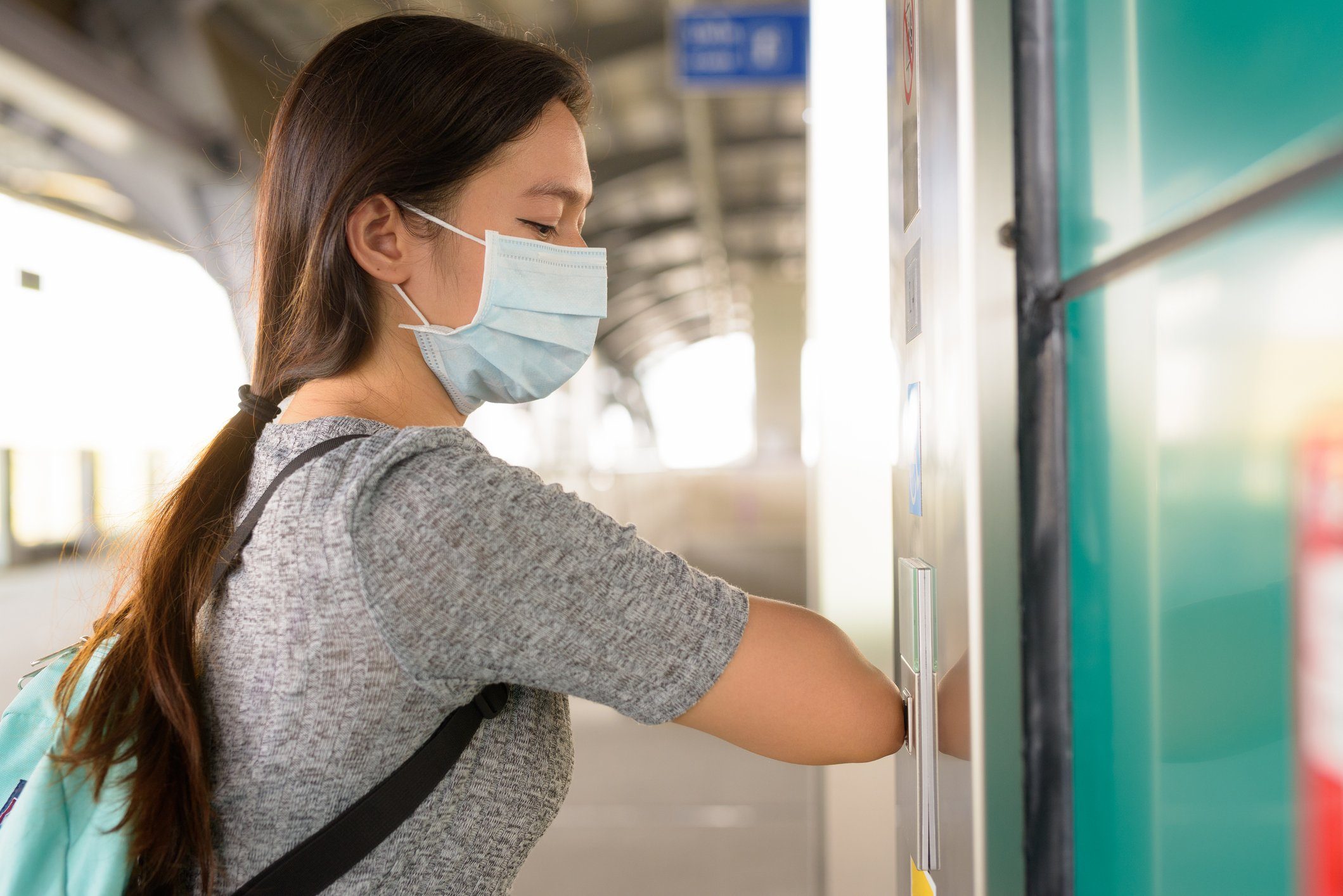
Don’t touch elevator buttons
In addition, you can wear “gloves if you must touch anything,” Willard says. But, “for elevator buttons, an elbow usually does the trick.” (Then, change and wash your clothes when you get home.) Disposable gloves are only effective if you refrain from touching your face when wearing them, and if you remove them correctly right afterward without contaminating yourself; for these reasons, the CDC still doesn’t recommend wearing gloves for the general public. Another option is to use a tissue to press any buttons and then discard it right away. But a good way to protect yourself is simply to “use hand sanitizers and do hand-washing as much as possible,” Willard says. Don’t touch your face, and after you get off the elevator, wash your hands as soon as you get to your workplace. (Avoid these common hand washing mistakes.)
Don’t talk
Those awkward elevator moments are about to get even more awkward. A June 2020 study published in PNAS has shown that loud talking may actually lead to greater spread of the virus, so some companies and buildings are banning talking on elevators. This is our new etiquette, so don’t worry about feeling rude by avoiding small talk with your fellow riders.
Take the stairs if you can
Best yet, avoid the elevator altogether. “Take the stairs: We often have a saying, ‘Walk up a flight or down two flights instead of an elevator,” Willard says. “If you can walk, it’s great exercise.” This won’t be possible if you’re on the 30th floor, but consider it if you’re on the third—even if that means you take the elevator up but walk down. Start slow, and consider it a new fitness regimen.
“Risks may include fatigue if you are out of shape, but stair climbing is a great way to include exercise into your daily routines,” Willard says. “A friend of mine would climb 10 stories every day to her office when she came in.” That’s a lot, but do what you can. (Find out what happens when you start walking 10,000 steps a day.)
But stairs have risks, too
The CDC advises stairwells to be designated one-way, so hopefully, you won’t have to pass people in the opposite direction. Still, “stairs can also get crowded, so consider distance,” Willard says. Again, be careful of what you’re touching; use your elbow to open doors if you can and use the handrails only if needed for safety. “Wash your hands when you get to your destination, and until then don’t touch your face,” she says.
Next, find out the coronavirus mistakes to avoid this summer.
Irv Gershbain, 87, resident at Kensington Gardens, Toronto.
I moved to Kensington Gardens long-term care home in downtown Toronto in fall 2019. I had been on the waiting list for over a year, hoping to join my wife, Doreen. We’ve been married 62 years and she moved into Kensington in August 2018. Before that, we’d never been apart.
When I first moved in, we had rooms on separate floors. We visited each other often, though, and ate dinner together every night. Doreen has dementia. It affects her memory and sometimes her judgment, but otherwise she’s pretty hip and with it. We’re both 87, born three days apart. I’m almost completely blind from macular degeneration. I have 10 per cent peripheral vision in one eye and none in the other.
Doreen and I complement each other. She reads me the sports section. I remind her of stories from our life together. We listen to all kinds of music: Ella Fitzgerald, Kenny Rogers, Leonard Cohen. Sometimes Doreen sings along. She remembers so many lyrics.
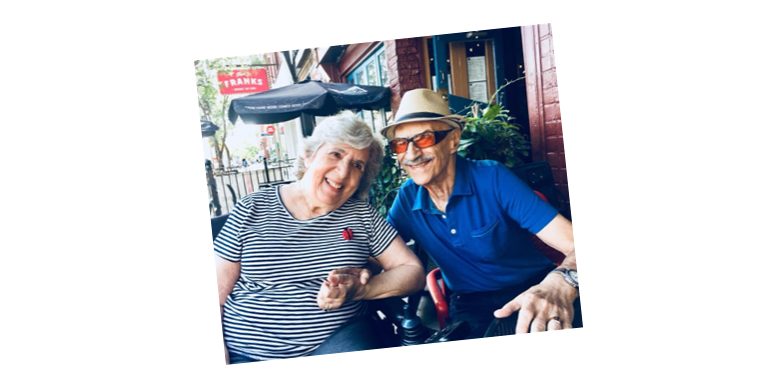
Our life together in Kensington changed in mid-March when COVID-19 was declared a pandemic in Canada. Everything went into lockdown, including our home. Residents were confined to our floors. And, if there was a case of COVID-19 on our floor, we were confined to our rooms.
On March 14, staff emailed family members and said they could no longer visit. In my experience, all information about the lockdown and the number of cases was communicated through our families—not to us. If I have one complaint about how things were managed at Kensington, it’s that nobody talked about any of this directly with me. I know that not everyone here would have been able to understand and handle it, but I can.
The day Kensington shut down visits, my daughter, Nikki, pretended not to see the email and rushed right over to get in one last visit. Doreen and I had no idea she was coming—or that this was the last chance we’d have to see each other for who knew how long. No one expected that our families would be kept away.
When Nikki arrived, we were sitting in the lobby. Before the pandemic, we often spent time there reading the paper and visiting with friends. That day, Nikki ran in all upset. She’d been trying to reach us in our rooms. I had no idea the home had sent out the announcement and didn’t sense her urgency. She told us what was going on and we quickly got down to the business of hugging and promising to call.
Within days, I was told I had to stay in my room. The woman across the hall from me had COVID-19. I believe she was the first case at Kensington. Staff didn’t tell me—I just guessed. But you’d have to be stupid not to realize what was happening. There was so much coming and going. I’m blind and I knew. A few days after I guessed what was going on, they e-mailed Nikki to officially let her know. After that, she received regular updates that she’d pass along to me.
Initially, it was very scary. I was constantly worrying and wiping down my doorknobs with a soapy washcloth. I spent almost two months in my room. Meals and snacks were brought to me. Nikki pushed to get a little exercise machine. So I pedalled, did calisthenics and listened to the news. I learned to deal with the isolation. What are you going to do? I talked to Doreen and my kids on the phone and we even had a Zoom Passover Seder. I appreciate the staff’s hard work. I want to keep living.
Doreen snuck up to my room a few times—just got on the elevator and up she came. The first time, about a month into our quarantine, I sent her packing. I was so worried she’d contract COVID-19. Then I felt terrible because I missed a chance to visit. We’d only been together again for five months before the lockdown. The next time I let her stay. I hugged and kissed her, and we had a lovely visit. The third time she got caught and staff threatened to put an alarm on her wheelchair. So that was that.
I was constantly anxious. My wife’s the most important thing in my life. Before I moved into Kensington, we visited three times a week. It was hard for us both to be separated for those 14 months. Once I was here to stay, Doreen became more herself again, reading and participating in activities. She’s very stoic and refuses to ask for help. There’s a tumour in her stomach and it’s my job to make sure she takes her pills before the pain gets too bad. In lockdown, who’s going to do that? I’m the only person she tells.
By early May, the woman across the hall recovered. But not everybody did. As of June 19, we have had 25 cases, and eight of those people died. I consider myself lucky. I listen to the news. I know what’s happening in other homes. In total, more than 950 residents have died in long-term care homes across Ontario. Other residents are being left alone in their rooms all day, with no one checking in, bathing or changing them. It’s tragic.
Today, there are no more cases at Kensington Gardens. A few weeks ago, I was able to move onto Doreen’s floor and we no longer have to stay in our rooms. They even let us out into the courtyard. It’s kind of like prison—one hour of exercise a day.
The province only just started allowing visits again on June 18 but it’s still very restrictive. Visitors have to get a COVID-19 test every two weeks and we can only meet one-on-one. We cannot gather together. Before that, we yelled from the balcony—with me on the third floor and Doreen on the second. Nikki would come visit us, along with my daughter-in-law Kavita, their kids and the dog all outside on the street. Boy did all that yelling embarrass the young teenagers.
I cannot wait to see them all again, but I know we’re always one outbreak away from being locked back down. Still, I can’t complain. Life is so hard right now for so many people. I get to feel safe again and be with Doreen.
Next, find out what it’s like to have a baby during the COVID-19 lockdown.
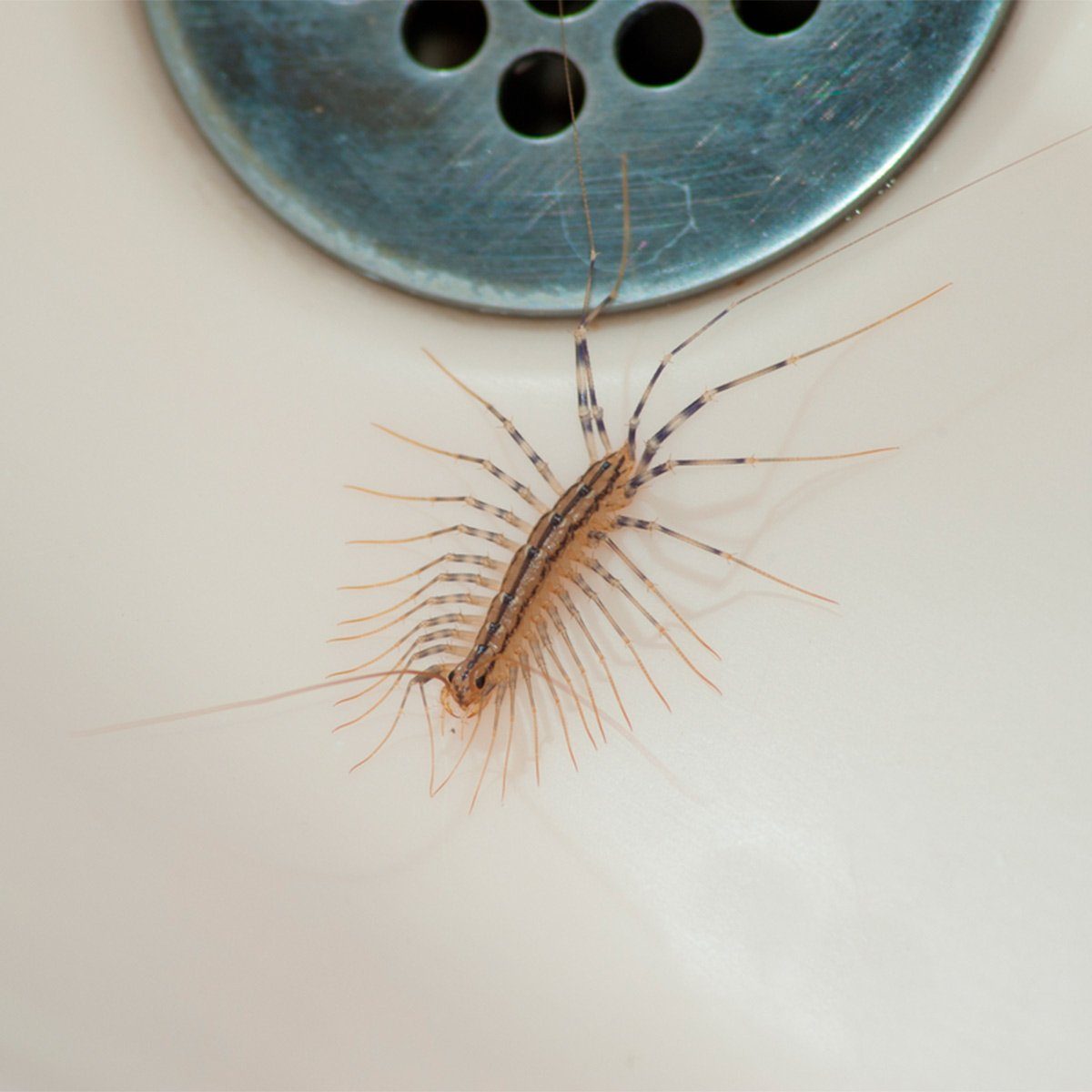
There’s nothing more terrifying than watching a house centipede shoot across your floor and under your couch. It’s safe to say that most people are positively terrified from those creepy crawling houseguests. House centipedes typically have 15 legs and can travel 1.3 feet-per-second, which explains why catching one of these centipedes in house is so difficult.
The typical response to a house centipede probably involves a shoe to squash the bugger before it crawls under another piece of furniture. Like almost every other bug out there, however, a centipede does have a purpose—and yes, that purpose is actually good.
What do centipedes eat?
House centipedes are known for killing pests in your house that are completely unwelcome. They kill roaches, moths, flies, silverfish and termites. Centipedes use the two legs right near their head, which has been modified to carry venom, and their other legs to scoop up the bug. This is called a “lassoing” technique where centipedes jump on their prey and wrap them up with the rest of their legs.
Not only are house centipedes killing the bugs you really don’t want in your house, they also don’t create any type of nests or webs as well. They are considered active hunters and are constantly looking for their next prey. Centipedes aren’t eating your wood and they aren’t carrying a fatal disease. House centipedes just want to go after the bugs.
How to get rid of centipedes in your home
- If you want to get rid of house centipedes for good, the trick is to get rid of the food centipedes source on.
- Try to get rid of the household pests that they prey on. You can do this by making sure there isn’t extra moisture in your walls by using a dehumidifier or installing a fan in the bathroom.
- Seal off any cracks entering the house so pests don’t have places to lay eggs.
- Make sure to clear your house of any debris that is causing unnecessary moisture to leak into your walls.
Next, learn about the pests that could be hiding in your attic.
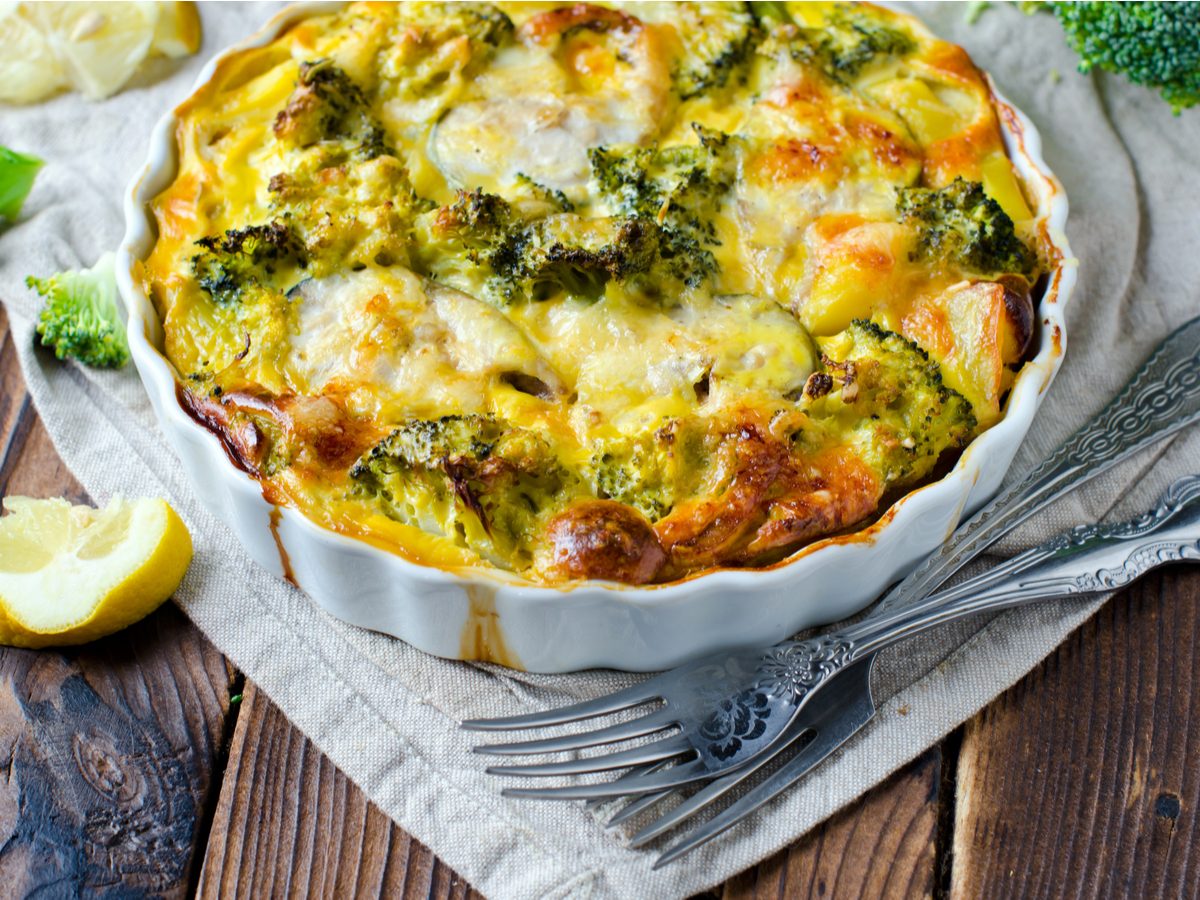
Cooking Through Grief
My mother-in-law tells me she’s coming over, so I lock the front door. My four-year old twins stand with their hands and faces pressed against the window. Their excited breath fogs up the glass and they write their names to pass the time. I need to keep them inside—it’s early April and Toronto is in lockdown—but I know they won’t be able to resist hugging their grandmother without being restrained.
“She’s wearing a mask,” I hear one whisper to the other as she gets out of the car.
They’ve never seen such a thing, their Bubby wearing a mask, and they’re unsure, a little afraid. But as she gets closer, they see her holding a large dish in her gloved hands and an old rum Tortuga cake box piled with cookies.
“Is that for us?” the boys ask.
She puts it down on the porch as the boys hold up their drawings for her to see through the door. Her bright eyes are still visible and you just know she’s smiling under her N95.
We are grateful to have dinner brought to us tonight. A crisis really calls for a casserole. And a global pandemic forcing us to isolate at home indefinitely? That calls for Carol’s broccoli cheese casserole, with its layers of melted cheese, mushroom soup and soft vegetables, sprinkled with toasted breadcrumbs. It’s a recipe she learned at a cooking class hosted by her synagogue’s sisterhood 30 years ago.
“But I add an extra layer of cheese,” she tells me.
That’s the kind of person she is—the kind to go rogue with cheese when the situation calls for it. She’s also the kind of person who continues to care for her loved ones while in the middle of deep personal grief.
Only three months before bringing us this casserole, in January, Carol lost her husband of 50 years. Yet, each week she offers meatballs, chicken soup or blueberry muffins—still warm from her oven—inside of yogurt containers she sets aside for such deliveries.
“I Talk to Him While I Cook”
Carol and my father-in-law, Ron, were set up on a blind date in December 1966 while she was still in high school and he was studying engineering at the University of Toronto. Two and a half years later, they married and eventually had four kids. Even later in life, when I met them, their partnership was filled with the joyful energy of a good hora and the soulfulness of a mezinke—the dance performed at Ashkenazi weddings when a youngest child is married off. It was done at my wedding to their fourth, and last, child. I still vividly remember seeing Ron and Carol on the dance floor wearing floral crowns and big smiles, encircled by friends and family clapping and singing and celebrating them.
When Ron died, Carol took great comfort in the Jewish tradition of shiva, a week-long period of mourning where people visit the family home of the deceased. She’s always been a social person, collecting people like the dozen dreidels displayed in the glass case in her dining room. But when COVID-19 struck, no one could be there by her side any longer.
Carol feels Ron’s absence every day in their apartment. At meals, his seat at the table is empty. He’s not on the balcony to share a cup of coffee as she watches the city go by. And he’s not on the couch next to her at night to watch a show on television. But, she tells me, since she made all their meals for them when he was alive, she still feels connected to him when she cooks. And so, she cooks.
“I talk to him while I cook,” she says. “I’m making kugel now and I’ll say ‘Ronnie you loved this kugel. You loved putting sour cream on this kugel. Too much sour cream. I’m sorry you won’t be here to eat it.’”
The Love Goes On
I find myself thinking about Carol alone in her kitchen, preparing food. I think about all the steps that go into making the casserole. I imagine her standing over the counter, grating the cheese, and then the extra cheese, opening the soup cans, washing the broccoli and cauliflower, chopping them into florets, dividing them into four separate dishes for the families of her four children.
“Do you steam the veggies first?” I asked her at one drop off, although what I was really asking was: How are you doing this? How are you grieving in such uncertain times without even the comfort of being surrounded by the people who love you?
“Yes,” she says. “Just enough to make them soft.”
Then she tells me she’ll be dropping a kugel off later in the week. My boys will savour the sweet forkfuls of pasta and ricotta. I will too, even though I’m lactose intolerant, because the constancy of her deliveries eases the stress and anxiety of trying to raise toddlers during a pandemic.
From Carol I’ve learned that grief is love and love is food and none of that stops just because we are all separated, by quarantine or more. We still eat, and we still love and we still mourn.
This is what I want to tell my boys when they ask where their Zaidy has gone and why is Bubby standing so far away. Instead, I give them blueberry muffins. And as they peel off the heart paper wrappers, I tell them, “Bubby made those specially for you.”
Next, read about how one woman tried to be a good neighbour during COVID-19.
